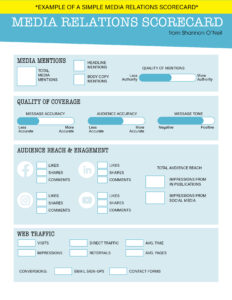Compared to digital advertising, media relations presents a unique challenge when it comes to measuring return on investment (ROI). In paid media campaigns, metrics like click-through rates, impressions, and conversion data provide clear insights into performance.
But earned media—news articles, interviews, and press coverage—doesn’t come with built-in tracking links or ad spend calculations, making its impact harder to quantify. This lack of direct attribution often leaves businesses questioning the true value of their media efforts.
However, in today’s data-driven business world, understanding how media coverage influences brand awareness, credibility, and conversions is more important than ever. While measuring media relations ROI may not be as straightforward as tracking paid advertising, it is far from impossible.
By using a mix of qualitative and quantitative metrics, businesses can gain valuable insights into how media exposure drives engagement, shapes public perception, and ultimately contributes to the bottom line.
Define Your Goals and KPIs
Before measuring the success of your media relations, it’s essential to establish clear goals and key performance indicators (KPIs). Common objectives might include increasing brand awareness, improving reputation, driving website traffic, or generating leads.
Once you’ve defined these goals, identify the metrics that will help you measure progress. For example, you might want to track the number of media mentions, the tone and quality of coverage, the reach and impressions of your placements, and specific engagement metrics like website visits or conversions that result from media exposure.
Track Media Mentions
Monitoring media mentions is the cornerstone of evaluating media relations success. Use tools like Google Alerts, Meltwater, or Cision to keep track of when and where your business is mentioned. Pay attention not only to the volume of mentions but also to their prominence—are you featured in the headline or buried in the body of the article? Additionally, consider the quality of the outlets covering you. Being featured in an authoritative publication that aligns with your target audience carries more weight than a mention in a lesser-known source.
Evaluate the Quality of Coverage
Not all media coverage is created equal. It’s important to assess the quality and relevance of the stories that feature your business. Are journalists accurately conveying your key messages? Is the tone of the coverage positive, neutral, or negative? Positive mentions can boost your reputation, while negative ones may require immediate action to mitigate damage. Also, consider whether the coverage aligns with your target audience and industry. Coverage in niche or highly relevant outlets can often be more impactful than mentions in general publications.
Measure Audience Reach
Audience reach provides insights into how many people could potentially see your media coverage. This includes impressions, which represent the total number of times your message could be viewed based on the publication’s audience size. Social media metrics can further amplify this reach—track shares, comments, and other engagement indicators to understand how your message resonates with the public. Ultimately, the goal is to ensure that your coverage is reaching the right people, not just a large audience.
Analyze Website Traffic and Engagement
One of the most tangible ways to measure media relations success is by analyzing the impact on your website. Use tools like Google Analytics to track referral traffic from media sources and any changes in direct traffic, which may occur when people search for your business after reading about it. Evaluate engagement metrics such as the time visitors spend on your site, the number of pages they view, and any conversions, such as signing up for a newsletter or making a purchase. These data points can provide valuable insights into how media coverage drives meaningful interactions with your brand.
Create a Media Relations Scorecard
 Media Relations ScorecardTo tie all your metrics together, develop a media relations scorecard that tracks your KPIs in a structured way. Include metrics such as:
Media Relations ScorecardTo tie all your metrics together, develop a media relations scorecard that tracks your KPIs in a structured way. Include metrics such as:
- Number of media mentions
- Quality of coverage (positive/neutral/negative)
- Audience reach and impressions
- Website traffic and conversions
- Engagement metrics (e.g., social shares, comments)
Update this scorecard regularly to identify trends, assess the effectiveness of your strategies, and provide a clear report for stakeholders. A well-maintained scorecard ensures that you’re always informed about the impact of your media relations efforts and can make data-driven adjustments to improve results.
Check out this example of a simple media relations scorecard I created. This would be perfect to use to demonstrate month-to-month growth in media relations for leadership and other stakeholders. >>>>
Bonus Tips for Long-Term Success
Monitor Impact on Brand Awareness
To gauge the long-term success of your media relations, assess changes in brand awareness and reputation. This can be done through surveys, focus groups, or brand studies to measure recognition and recall among your target audience. Consider tracking shifts in public perception and overall sentiment toward your business over time, as well as any noticeable improvements in your industry reputation.
Use Social Listening Tools
Social listening can provide real-time insights into how people are reacting to your media coverage. Track mentions of your brand on social media platforms, paying attention to the volume, sentiment, and context of these conversations. Analyze hashtags, keywords, and overall engagement to understand how the public perceives your brand after media placements. These insights can help refine your messaging and identify opportunities for further engagement.
Evaluate Relationship Development with Journalists
Strong relationships with journalists are a cornerstone of successful media relations. Assess whether your outreach efforts have made you a trusted source for the media. Are journalists responding to your pitches more frequently or reaching out to you for commentary? Have you been invited to provide op-eds or expert opinions? Building and maintaining these connections can lead to more frequent and favorable coverage in the future.
Turning Media Coverage Into Measurable Success
While media relations may not offer the same immediate, trackable ROI as digital advertising, its impact on brand awareness, credibility, and audience engagement is undeniable. By using a combination of media monitoring, website analytics, and other engagement assessments, businesses can gain a clearer picture of how press coverage is driving real results. The key is to move beyond simply tracking mentions and focus on the broader influence that media exposure has on business growth and customer behavior.
Need help?
With experience in media relations for nonprofits, public institutions, and corporations, I understand the challenges of measuring media impact and the strategies that make a media campaign truly effective. If you’re looking for a communications professional who can bridge the gap between PR and data-driven results, I am currently seeking new opportunities and would love to connect. Let’s discuss how strategic media relations can elevate your brand and contribute to your business goals. Connect with me on LinkedIn or send me an email!





